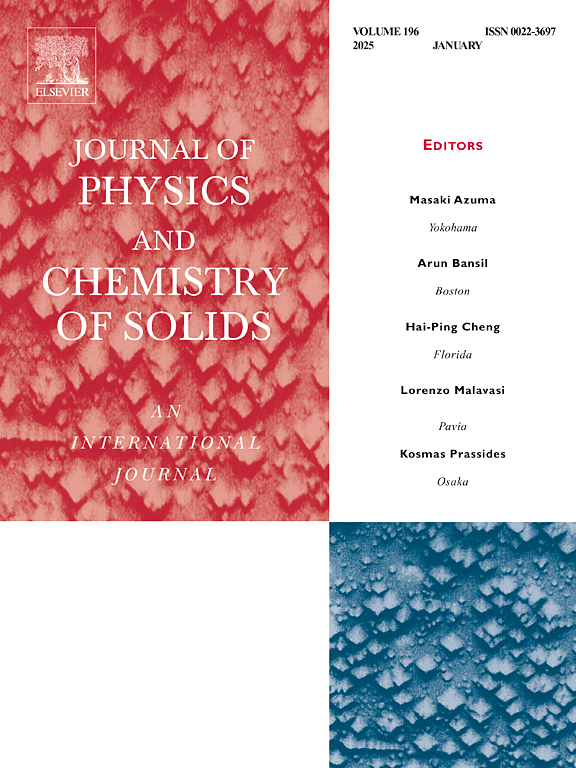MgO NPs掺杂对聚乙烯氧化物(PEO)纳米复合聚合物电解质光电和电化学行为的影响
IF 4.3
3区 材料科学
Q2 CHEMISTRY, MULTIDISCIPLINARY
引用次数: 0
摘要
纳米复合聚合物电解质为可充电镁离子电池提供了新的选择。镁是一种二价电荷载体,与其他金属(如锂离子或钠离子)相比,它具有许多优点。镁电池因其低成本和可靠的技术而受到越来越多的关注。本研究采用Gaussian 09软件和Gauss View 6.0,对聚乙烯氧化物(PEO)8和纳米氧化镁(MgO)掺杂(PEO)8的纳米复合聚合物电解质进行了研究,探讨了体系的结构、电子和电化学性能。采用B3LYP方法和6-31G基集,利用密度泛函方法对其结构进行了优化,并获得了其XRD、UV-vis-nir、IR、Raman、NMR、Mulliken电荷分析和分子静电势等性能。利用HOMO-LUMO能隙计算纯PEO的带隙为6.28 eV,表明其具有绝缘性能。加入MgO纳米粒子后,(PEO)8-MgO-(PEO)8的带隙减小到4.96 eV,电导率略高。分子静电势(MEP)图谱显示(PEO)8- mgo -(PEO)8中电荷密度分布均匀,突出了离子相互作用的有利位点。Mulliken种群分析表明,聚合物主链上的电子密度增加,证实了PEO在纳米复合聚合物电解质体系中的路易斯碱行为。DFT计算的结果,结合对结构和电化学行为的见解,探索了(PEO)8- mgo -(PEO)8纳米复合材料作为高效固态聚合物电解质的潜力。该研究为设计用于下一代储能器件的先进聚合物基材料提供了理论基础。本文章由计算机程序翻译,如有差异,请以英文原文为准。
Effect of MgO NPs doping on the optoelectronic and electrochemical behavior of polyethylene oxide (PEO) nanocomposite polymer electrolyte
Nanocomposite polymer electrolytes provide new alternatives for rechargeable magnesium ion batteries. Magnesium is a divalent charge carrier with several advantages over other metals, such as Li or Na ions for battery applications. Magnesium batteries have gained increasing attention because of their low-cost and reliable technology. In this study, nanocomposite polymer electrolytes based on polyethylene oxide (PEO)8 and magnesium oxide (MgO) nanoparticles doped -MgO- were investigated using Gaussian 09 software with Gauss View 6.0 to explore the system's structural, electronic, and electrochemical properties. The density functional approach has been utilized with the B3LYP method and 6-31G basis set to optimize the structures and obtain their properties such as XRD, UV–vis-nir, IR, Raman, NMR, Mulliken charge analysis, and Molecular electrostatic potential. The band gap of pure PEO, calculated using the HOMO-LUMO energy gap, was found to be 6.28 eV, indicating insulating properties. Upon the addition of MgO nanoparticles, the band gap of -MgO- decreased to 4.96 eV, suggesting slightly high electronic conductivity. Molecular electrostatic potential (MEP) mapping demonstrated a uniform charge density distribution in -MgO-, highlighting favorable sites for ionic interactions. Mulliken population analysis showed an increase in electron density on the polymer backbone, confirming the Lewis base behavior of PEO in the nanocomposite polymer electrolytes system. The results from DFT calculations, combined with insights into structural and electrochemical behavior, explore the potential of -MgO- nanocomposites as efficient solid-state polymer electrolytes. This study provides a theoretical foundation for designing advanced polymer-based materials for next-generation energy storage devices.
求助全文
通过发布文献求助,成功后即可免费获取论文全文。
去求助
来源期刊
CiteScore
7.80
自引率
2.50%
发文量
605
审稿时长
40 days
期刊介绍:
The Journal of Physics and Chemistry of Solids is a well-established international medium for publication of archival research in condensed matter and materials sciences. Areas of interest broadly include experimental and theoretical research on electronic, magnetic, spectroscopic and structural properties as well as the statistical mechanics and thermodynamics of materials. The focus is on gaining physical and chemical insight into the properties and potential applications of condensed matter systems.
Within the broad scope of the journal, beyond regular contributions, the editors have identified submissions in the following areas of physics and chemistry of solids to be of special current interest to the journal:
Low-dimensional systems
Exotic states of quantum electron matter including topological phases
Energy conversion and storage
Interfaces, nanoparticles and catalysts.

 求助内容:
求助内容: 应助结果提醒方式:
应助结果提醒方式:


